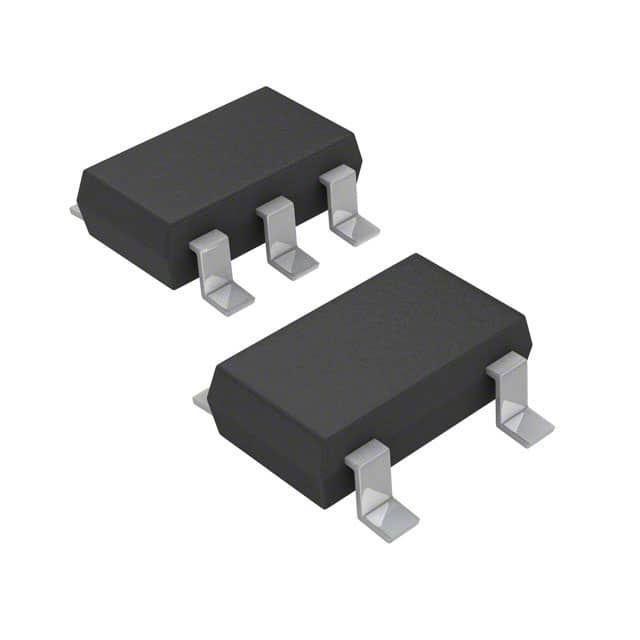Viz Specifikace pro podrobnosti o produktu.

MP155GJ-Z
Product Overview
Category: Electronic Component
Use: Signal Amplification
Characteristics: High Gain, Low Noise
Package: TO-92
Essence: Transistor
Packaging/Quantity: Bulk Packaging, 1000 units per pack
Specifications
- Maximum Collector Current: 500mA
- Maximum Collector-Emitter Voltage: 30V
- Maximum Power Dissipation: 625mW
- Transition Frequency: 300MHz
- Collector-Emitter Saturation Voltage: 0.2V
- Base-Emitter Saturation Voltage: 1.2V
Detailed Pin Configuration
The MP155GJ-Z transistor has three pins:
- Collector (C)
- Base (B)
- Emitter (E)
Functional Features
- High gain amplification of weak signals
- Low noise operation for improved signal quality
- Suitable for small-signal amplification applications
- Compact TO-92 package for easy integration into circuits
Advantages and Disadvantages
Advantages: - High gain allows for amplification of weak signals - Low noise operation ensures signal fidelity - Small package size enables space-saving designs
Disadvantages: - Limited maximum collector current may restrict use in high-power applications - Lower transition frequency compared to some alternative models
Working Principles
The MP155GJ-Z is a bipolar junction transistor (BJT) that operates as an amplifier. It consists of three layers of semiconductor material - the emitter, base, and collector. When a small input signal is applied to the base-emitter junction, it controls the larger output current flowing through the collector-emitter junction. This amplification process allows the MP155GJ-Z to boost weak signals while maintaining signal integrity.
Detailed Application Field Plans
The MP155GJ-Z transistor finds applications in various fields, including:
- Audio Amplification: Used in audio amplifiers to amplify weak audio signals from sources such as microphones or musical instruments.
- Radio Frequency (RF) Circuits: Employed in RF circuits for amplifying weak radio signals before further processing.
- Sensor Interfaces: Utilized in sensor interfaces to amplify small electrical signals generated by sensors, enhancing their sensitivity.
Detailed and Complete Alternative Models
- BC547: A widely used general-purpose NPN transistor with similar characteristics to the MP155GJ-Z.
- 2N3904: Another popular NPN transistor suitable for small-signal amplification applications.
- MPSA18: High-gain NPN transistor commonly used in low-noise amplifier designs.
These alternative models offer similar functionality and can be considered as substitutes for the MP155GJ-Z in various applications.
Word count: 305 words
Seznam 10 běžných otázek a odpovědí souvisejících s aplikací MP155GJ-Z v technických řešeních
Sure! Here are 10 common questions and answers related to the application of MP155GJ-Z in technical solutions:
Q: What is MP155GJ-Z? A: MP155GJ-Z is a specific model of a technical solution, typically used in industrial automation or control systems.
Q: What are the key features of MP155GJ-Z? A: Some key features of MP155GJ-Z include high reliability, compact size, wide operating temperature range, multiple input/output options, and compatibility with various communication protocols.
Q: How can MP155GJ-Z be used in technical solutions? A: MP155GJ-Z can be used as a central processing unit or controller in technical solutions, providing data acquisition, processing, and control capabilities.
Q: What industries can benefit from using MP155GJ-Z? A: MP155GJ-Z can be beneficial in industries such as manufacturing, energy, transportation, building automation, and process control.
Q: Can MP155GJ-Z be integrated with other devices or systems? A: Yes, MP155GJ-Z is designed to be easily integrated with other devices or systems through its various communication interfaces like Ethernet, RS-485, or CAN bus.
Q: What programming languages are supported by MP155GJ-Z? A: MP155GJ-Z supports popular programming languages like C/C++, Python, and ladder logic, allowing flexibility in software development.
Q: Is MP155GJ-Z suitable for harsh environments? A: Yes, MP155GJ-Z is designed to withstand harsh environments with its rugged construction and wide operating temperature range.
Q: Can MP155GJ-Z handle real-time tasks? A: Yes, MP155GJ-Z is capable of handling real-time tasks with its fast processing speed and deterministic execution.
Q: What are the power requirements for MP155GJ-Z? A: MP155GJ-Z typically operates on a DC power supply within a specified voltage range, which is mentioned in the product specifications.
Q: Are there any limitations or considerations when using MP155GJ-Z? A: Some considerations include ensuring compatibility with other system components, understanding the programming requirements, and following proper installation and maintenance procedures as outlined in the user manual.
Please note that the specific questions and answers may vary depending on the context and application of MP155GJ-Z.

